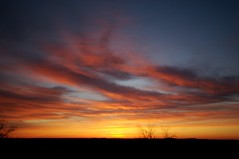I have only "professionaly" printed one of my photographs. I think the term to use is "Large Format Printing". I think the final size was 30x20. It was a request from someone who wanted it above their mantel. For this article's sake, let's assume it was similar to this one:
My problem was I knew next to nothing about printers. In fact, we have multiple color laser printers at work that do 8.5x11 normal sheet prints. Every single time I've attempted to use them, I had different results. Whether it was printing from driver version X, Y, Z, or color detail "high" or "photo" or printing straight from Photoshop or from Photoshop through Aperture. It all frustrated me enough that I've always tried desperately not to print anything. It's easier to email, post to flickr, .mac or just make a website/webpage to share the photos.
Then it just so happened that I went to a The Columbus Digital Photography and Photoshop Meetup Group meeting at a coffee house one evening and found out the organizer prints out many different photographs, some in very, very large sizes. I thought I'd hit the jackpot of knowledge! He recommended Signway Graphics . After much procrastination and surfing trying to figure out color spaces, bleeds, dimensions, pixel rules, etc, I relented and contacted Signway to have my print made.
And it turned out fantastic! Signway was great. The cost was very reasonable. You can take your photo(s) in on a USB drive/CD or email them. The owners are very, very, patient. I didn't know that much about how all this "print stuff" works.
Here are some of the things I learned through the process:
Megapixels File Resolution Print Size
High Quality (300dpi) Max(150dpi)
4 2664x1632 8"x5.5" 16.5"x11"
8 3264x2448 11"x8" 22"x16"
10 4290x2800 13"x8.5" 26"x17"
So, when I compare my Canon 40D  I get 3892 × 2586 (or 3888x2592). Which if you take a Pixels-per-Inch (PPI) of 300 that's 3888/300 = 12.96 inches wide by 2492/300 = 8.64 inches tall.
I get 3892 × 2586 (or 3888x2592). Which if you take a Pixels-per-Inch (PPI) of 300 that's 3888/300 = 12.96 inches wide by 2492/300 = 8.64 inches tall.
Whether I alter the PPI, downsize the photo, upsize it, or any combination thereof depends on the physical printing device that's being used.
You can use Photoshop or any image editting program to resize your digital file so you can print it bigger. Here is a link to a free how-to (using Photoshop). If you don't have photoshop, you can probably very easily adapt it to whatever image editting application you are using:
Resizing Practice Exercises for Photoshop CS2 Basics Lesson 2
This resizing seems to be an art in and of itself (like everything with this digital photgraphy stuff eh?)
I hope this helps someone. I'm definitely not an expert regarding any of this. But I spent a good bit of time surfing and skimming books at the library and Borders (and drinking coffee with the group!) trying to make heads or tails of it all. Hopefully this saved you some time.
One last prop: Signway Graphics.
Credits:
Canon 40d photo
Sunday, April 20, 2008
Printing a photograph for above-the-mantel
Posted by
lottadot
at
8:52 AM
![]()
![]()
Labels: Canon40d, Photography, Printing
Subscribe to:
Post Comments (Atom)
 When Ghosts Speak: Understanding the World of Earthbound Spirits
When Ghosts Speak: Understanding the World of Earthbound Spirits Cocoa(R) Programming for Mac(R) OS X
Cocoa(R) Programming for Mac(R) OS X The Moment It Clicks: Photography secrets from one of the world's top shooters
The Moment It Clicks: Photography secrets from one of the world's top shooters
0 comments:
Post a Comment